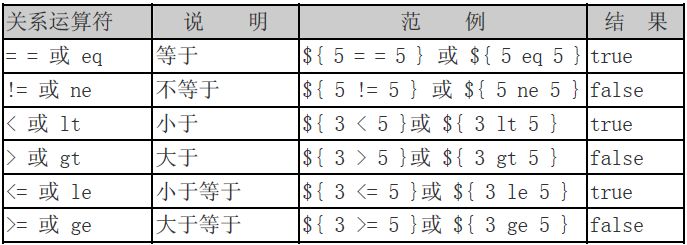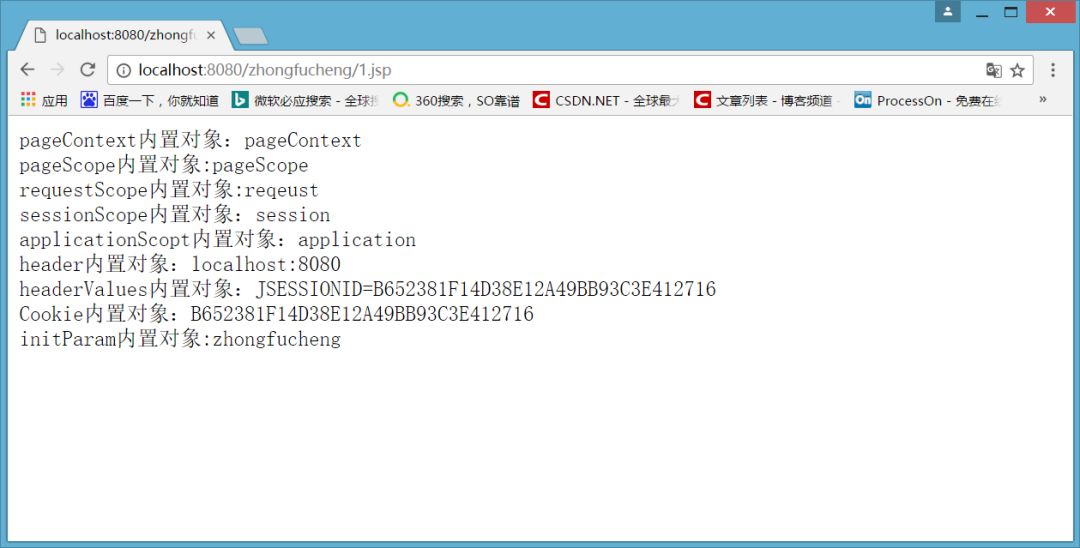前言
只有光头才能变强。
文本已收录至我的GitHub仓库,欢迎Star:https://github.com/ZhongFuCheng3y/3y
什么是EL表达式?
表达式语言(Expression Language,EL),EL表达式是用"${}"括起来的脚本,用来更方便的读取对象!
为什么要使用EL表达式?
<%@ page language="java" contentType="text/html" pageEncoding="UTF-8"%><html><head> <title>向session设置一个属性</title></head><body><% //向session设置一个属性 session.setAttribute("name", "aaa"); System.out.println("向session设置了一个属性");%></body></html>"text/html" pageEncoding="UTF-8"%>
<html>
<head>
<title>向session设置一个属性</title>
</head>
<body>
<%
//向session设置一个属性
session.setAttribute("name", "aaa");
System.out.println("向session设置了一个属性");
%>
</body>
</html>
<%@ page contentType="text/html;charset=UTF-8" language="java" %><html><head> <title></title></head><body><% String value = (String) session.getAttribute("name"); out.write(value);%></body></html>"java" %>
<html>
<head>
<title></title>
</head>
<body>
<%
String value = (String) session.getAttribute("name");
out.write(value);
%>
</body>
</html>

<%@ page contentType="text/html;charset=UTF-8" language="java" %><html><head> <title></title></head><body>${name}</body></html>"java" %>
<html>
<head>
<title></title>
</head>
<body>
${name}
</body>
</html>

EL表达式的作用
${标识符}获取各类数据
获取域对象的数据
<% //向ServletContext设置一个属性 application.setAttribute("name", "aaa"); System.out.println("向application设置了一个属性");%>//向ServletContext设置一个属性
application.setAttribute("name", "aaa");
System.out.println("向application设置了一个属性");
%>
<% ${name}%>
%>

获取JavaBean的属性
<jsp:useBean id="person" class="domain.Person" scope="session"/><jsp:setProperty name="person" property="age" value="22"/>class="domain.Person" scope="session"/>
<jsp:setProperty name="person" property="age" value="22"/>
在2.jsp中取出Session的属性
<% Person person = (Person) session.getAttribute("person"); System.out.println(person.getAge());%>
Person person = (Person) session.getAttribute("person");
System.out.println(person.getAge());
%>

//等同于person.getAge()${person.age}
${person.age}

获取集合的数据
<% List<Person> list = new ArrayList(); Person person1 = new Person(); person1.setUsername("zhongfucheng"); Person person2 = new Person(); person2.setUsername("ouzicheng"); list.add(person1); list.add(person2); session.setAttribute("list",list);%>new ArrayList();
Person person1 = new Person();
person1.setUsername("zhongfucheng");
Person person2 = new Person();
person2.setUsername("ouzicheng");
list.add(person1);
list.add(person2);
session.setAttribute("list",list);
%>
<% List<Person> list = (List) session.getAttribute("list"); out.write(list.get(0).getUsername()+"<br>"); out.write(list.get(1).getUsername());%>
List<Person> list = (List) session.getAttribute("list");
out.write(list.get(0).getUsername()+"<br>");
out.write(list.get(1).getUsername());
%>
使用EL表达式又是怎么样的效果呢?我们来看看!
<%--取出list集合的第1个元素(下标从0开始),获取username属性--%>${list[0].username}<br><%--取出list集合的第2个元素,获取username属性--%>${list[1].username}0开始),获取username属性--%>
${list[0].username}
<br>
<%--取出list集合的第2个元素,获取username属性--%>
${list[1].username}

<% Map<String, Person> map = new HashMap<>(); Person person1 = new Person(); person1.setUsername("zhongfucheng1"); Person person2 = new Person(); person2.setUsername("ouzicheng1"); map.put("aa",person1); map.put("bb",person2); session.setAttribute("map",map);%>
Map<String, Person> map = new HashMap<>();
Person person1 = new Person();
person1.setUsername("zhongfucheng1");
Person person2 = new Person();
person2.setUsername("ouzicheng1");
map.put("aa",person1);
map.put("bb",person2);
session.setAttribute("map",map);
%>
${map.aa.username}<br>${map.bb.username}
${map.bb.username}


${map["1"].username}<br>${map["2"].username}
<br>
${map["2"].username}
EL运算符


<% List<Person> list = null;%>${list==null?"list集合为空":"list集合不为空"}null;
%>
${list==null?"list集合为空":"list集合不为空"}

EL表达式11个内置对象
EL表达式主要是来对内容的显示,为了显示的方便,EL表达式提供了11个内置对象。
pageContext 对应于JSP页面中的pageContext对象(注意:取的是pageContext对象)
pageScope 代表page域中用于保存属性的Map对象
requestScope 代表request域中用于保存属性的Map对象
sessionScope 代表session域中用于保存属性的Map对象
applicationScope 代表application域中用于保存属性的Map对象
param 表示一个保存了所有请求参数的Map对象
paramValues表示一个保存了所有请求参数的Map对象,它对于某个请求参数,返回的是一个string[]
header 表示一个保存了所有http请求头字段的Map对象
headerValues同上,返回string[]数组。
cookie 表示一个保存了所有cookie的Map对象
initParam 表示一个保存了所有web应用初始化参数的map对象
<%--pageContext内置对象--%><% pageContext.setAttribute("pageContext1", "pageContext");%>pageContext内置对象:${pageContext.getAttribute("pageContext1")}<br><%--pageScope内置对象--%><% pageContext.setAttribute("pageScope1","pageScope");%>pageScope内置对象:${pageScope.pageScope1}<br><%--requestScope内置对象--%><% request.setAttribute("request1","reqeust");%>requestScope内置对象:${requestScope.request1}<br><%--sessionScope内置对象--%><% session.setAttribute("session1", "session");%>sessionScope内置对象:${sessionScope.session1}<br><%--applicationScope内置对象--%><% application.setAttribute("application1","application");%>applicationScopt内置对象:${applicationScope.application1}<br><%--header内置对象--%>header内置对象:${header.Host}<br><%--headerValues内置对象,取出第一个Cookie--%>headerValues内置对象:${headerValues.Cookie[0]}<br><%--Cookie内置对象--%><% Cookie cookie = new Cookie("Cookie1", "cookie");%>Cookie内置对象:${cookie.JSESSIONID.value}<br><%--initParam内置对象,需要为该Context配置参数才能看出效果【jsp配置的无效!亲测】--%>initParam内置对象:${initParam.name}<br>
pageContext.setAttribute("pageContext1", "pageContext");
%>
pageContext内置对象:${pageContext.getAttribute("pageContext1")}
<br>
<%--pageScope内置对象--%>
<%
pageContext.setAttribute("pageScope1","pageScope");
%>
pageScope内置对象:${pageScope.pageScope1}
<br>
<%--requestScope内置对象--%>
<%
request.setAttribute("request1","reqeust");
%>
requestScope内置对象:${requestScope.request1}
<br>
<%--sessionScope内置对象--%>
<%
session.setAttribute("session1", "session");
%>
sessionScope内置对象:${sessionScope.session1}
<br>
<%--applicationScope内置对象--%>
<%
application.setAttribute("application1","application");
%>
applicationScopt内置对象:${applicationScope.application1}
<br>
<%--header内置对象--%>
header内置对象:${header.Host}
<br>
<%--headerValues内置对象,取出第一个Cookie--%>
headerValues内置对象:${headerValues.Cookie[0]}
<br>
<%--Cookie内置对象--%>
<%
Cookie cookie = new Cookie("Cookie1", "cookie");
%>
Cookie内置对象:${cookie.JSESSIONID.value}
<br>
<%--initParam内置对象,需要为该Context配置参数才能看出效果【jsp配置的无效!亲测】--%>
initParam内置对象:${initParam.name}
<br>

注意事项:
<form action="/zhongfucheng/1.jsp" method="post">用户名:<input type="text" name="username"><br>年龄:<input type="text " name="age"><br>爱好:<input type="checkbox" name="hobbies" value="football">足球<input type="checkbox" name="hobbies" value="basketball">篮球<input type="checkbox" name="hobbies" value="table tennis">兵乓球<br><input type="submit" value="提交"><br></form>"post">
用户名:<input type="text" name="username"><br>
年龄:<input type="text " name="age"><br>
爱好:
<input type="checkbox" name="hobbies" value="football">足球
<input type="checkbox" name="hobbies" value="basketball">篮球
<input type="checkbox" name="hobbies" value="table tennis">兵乓球<br>
<input type="submit" value="提交"><br>
</form>
${param.username}<br>${param.age}<br>//没有学习jstl之前就一个一个写吧。${paramValues.hobbies[0]}<br>${paramValues.hobbies[1]}<br>${paramValues.hobbies[2]}<br>
${param.age}
<br>
//没有学习jstl之前就一个一个写吧。
${paramValues.hobbies[0]}
<br>
${paramValues.hobbies[1]}
<br>
${paramValues.hobbies[2]}
<br>


EL表达式回显数据
EL表达式最大的特点就是:如果获取到的数据为null,输出空白字符串""!这个特点可以让我们数据回显
<%--模拟数据回显场景--%><% User user = new User(); user.setGender("male"); //数据回显 request.setAttribute("user",user);%><input type="radio" name="gender" value="male" ${user.gender=='male'?'checked':'' }>男<input type="radio" name="gender" value="female" ${user.gender=='female'?'checked':'' }>女
User user = new User();
user.setGender("male");
//数据回显
request.setAttribute("user",user);
%>
<input type="radio" name="gender" value="male" ${user.gender=='male'?'checked':'' }>男
<input type="radio" name="gender" value="female" ${user.gender=='female'?'checked':'' }>女

EL自定义函数
EL自定义函数用于扩展EL表达式的功能,可以让EL表达式完成普通Java程序代码所能完成的功能
步骤:
public static String filter(String message) { if (message == null) return (null); char content[] = new char[message.length()]; message.getChars(0, message.length(), content, 0); StringBuilder result = new StringBuilder(content.length + 50); for (int i = 0; i < content.length; i++) { switch (content[i]) { case '<': result.append("<"); break; case '>': result.append(">"); break; case '&': result.append("&"); break; case '"': result.append("""); break; default: result.append(content[i]); } } return (result.toString());}
if (message == null)
return (null);
char content[] = new char[message.length()];
message.getChars(0, message.length(), content, 0);
StringBuilder result = new StringBuilder(content.length + 50);
for (int i = 0; i < content.length; i++) {
switch (content[i]) {
case '<':
result.append("<");
break;
case '>':
result.append(">");
break;
case '&':
result.append("&");
break;
case '"':
result.append(""");
break;
default:
result.append(content[i]);
}
}
return (result.toString());
}
<?xml version="1.0" encoding="ISO-8859-1"?><taglib xmlns="http://java.sun.com/xml/ns/javaee" xmlns:xsi="http://www.w3.org/2001/XMLSchema-instance" xsi:schemaLocation="http://java.sun.com/xml/ns/javaee http://java.sun.com/xml/ns/javaee/web-jsptaglibrary_2_1.xsd" version="2.1"> <tlib-version>1.0</tlib-version> <short-name>myshortname</short-name> <uri>/zhongfucheng</uri> <!--函数的描述--> <function> <!--函数的名字--> <name>filter</name> <!--函数位置--> <function-class>utils.HTMLFilter</function-class> <!--函数的方法声明--> <function-signature>java.lang.String filter(java.lang.String)</function-signature> </function></taglib>
<taglib xmlns="http://java.sun.com/xml/ns/javaee"
xmlns:xsi="http://www.w3.org/2001/XMLSchema-instance"
xsi:schemaLocation="http://java.sun.com/xml/ns/javaee http://java.sun.com/xml/ns/javaee/web-jsptaglibrary_2_1.xsd"
version="2.1">
<tlib-version>1.0</tlib-version>
<short-name>myshortname</short-name>
<uri>/zhongfucheng</uri>
<!--函数的描述-->
<function>
<!--函数的名字-->
<name>filter</name>
<!--函数位置-->
<function-class>utils.HTMLFilter</function-class>
<!--函数的方法声明-->
<function-signature>java.lang.String filter(java.lang.String)</function-signature>
</function>
</taglib>
<%@ page language="java" contentType="text/html" pageEncoding="UTF-8" %><%@taglib prefix="fn" uri="/WEB-INF/zhongfucheng.tld" %><html><head> <title></title></head><body>//完成了HTML转义的功能${fn:filter("<a href='#'>点我</a>")}</body></html>
<%@taglib prefix="fn" uri="/WEB-INF/zhongfucheng.tld" %>
<html>
<head>
<title></title>
</head>
<body>
//完成了HTML转义的功能
${fn:filter("<a href='#'>点我</a>")}
</body>
</html>

EL函数库(fn方法库)

<%@taglib prefix="fn" uri="http://java.sun.com/jsp/jstl/functions" %>"fn" uri="http://java.sun.com/jsp/jstl/functions" %>
contains:${fn:contains("zhongfucheng",zhong )}<br>containsIgnoreCase:${fn:containsIgnoreCase("zhongfucheng",ZHONG )}<br>endsWith:${fn:endsWith("zhongfucheng","eng" )}<br>escapeXml:${fn:escapeXml("<zhongfucheng>你是谁呀</zhongfucheng>")}<br>indexOf:${fn:indexOf("zhongfucheng","g" )}<br>length:${fn:length("zhongfucheng")}<br>replace:${fn:replace("zhongfucheng","zhong" ,"ou" )}<br>split:${fn:split("zhong,fu,cheng","," )}<br>startsWith:${fn:startsWith("zhongfucheng","zho" )}<br>substring:${fn:substring("zhongfucheng","2" , fn:length("zhongfucheng"))}<br>substringAfter:${fn:substringAfter("zhongfucheng","zhong" )}<br>substringBefore:${fn:substringBefore("zhongfucheng","fu" )}<br>toLowerCase:${fn:toLowerCase("zhonGFUcheng")}<br>toUpperCase:${fn:toUpperCase("zhongFUcheng")}<br>trim:${fn:trim(" zhong fucheng ")}<br><%--将分割成的字符数组用"."拼接成一个字符串--%>join:${fn:join(fn:split("zhong,fu,cheng","," ),"." )}<br>
containsIgnoreCase:${fn:containsIgnoreCase("zhongfucheng",ZHONG )}<br>
endsWith:${fn:endsWith("zhongfucheng","eng" )}<br>
escapeXml:${fn:escapeXml("<zhongfucheng>你是谁呀</zhongfucheng>")}<br>
indexOf:${fn:indexOf("zhongfucheng","g" )}<br>
length:${fn:length("zhongfucheng")}<br>
replace:${fn:replace("zhongfucheng","zhong" ,"ou" )}<br>
split:${fn:split("zhong,fu,cheng","," )}<br>
startsWith:${fn:startsWith("zhongfucheng","zho" )}<br>
substring:${fn:substring("zhongfucheng","2" , fn:length("zhongfucheng"))}<br>
substringAfter:${fn:substringAfter("zhongfucheng","zhong" )}<br>
substringBefore:${fn:substringBefore("zhongfucheng","fu" )}<br>
toLowerCase:${fn:toLowerCase("zhonGFUcheng")}<br>
toUpperCase:${fn:toUpperCase("zhongFUcheng")}<br>
trim:${fn:trim(" zhong fucheng ")}<br>
<%--将分割成的字符数组用"."拼接成一个字符串--%>
join:${fn:join(fn:split("zhong,fu,cheng","," ),"." )}<br>

<% User user = new User(); String likes[] = {"sing"}; user.setLikes(likes); //数据回显 request.setAttribute("user",user);%><%--java的字符数组以","号分割开,首先拼接成一个字符串,再判读该字符串有没有包含关键字,如果有就checked--%><input type="checkbox"${ fn:contains(fn:join(user.likes,","),"sing")?'checked':'' }>唱歌<input type="checkbox"${ fn:contains(fn:join(user.likes,","),"dance")?'checked':'' }>跳舞new User();
String likes[] = {"sing"};
user.setLikes(likes);
//数据回显
request.setAttribute("user",user);
%>
<%--java的字符数组以","号分割开,首先拼接成一个字符串,再判读该字符串有没有包含关键字,如果有就checked--%>
<input type="checkbox"${ fn:contains(fn:join(user.likes,","),"sing")?'checked':'' }>唱歌
<input type="checkbox"${ fn:contains(fn:join(user.likes,","),"dance")?'checked':'' }>跳舞

最后
乐于输出干货的Java技术公众号:Java3y。公众号内有200多篇原创技术文章、海量视频资源、精美脑图,不妨来关注一下!























 被折叠的 条评论
为什么被折叠?
被折叠的 条评论
为什么被折叠?








